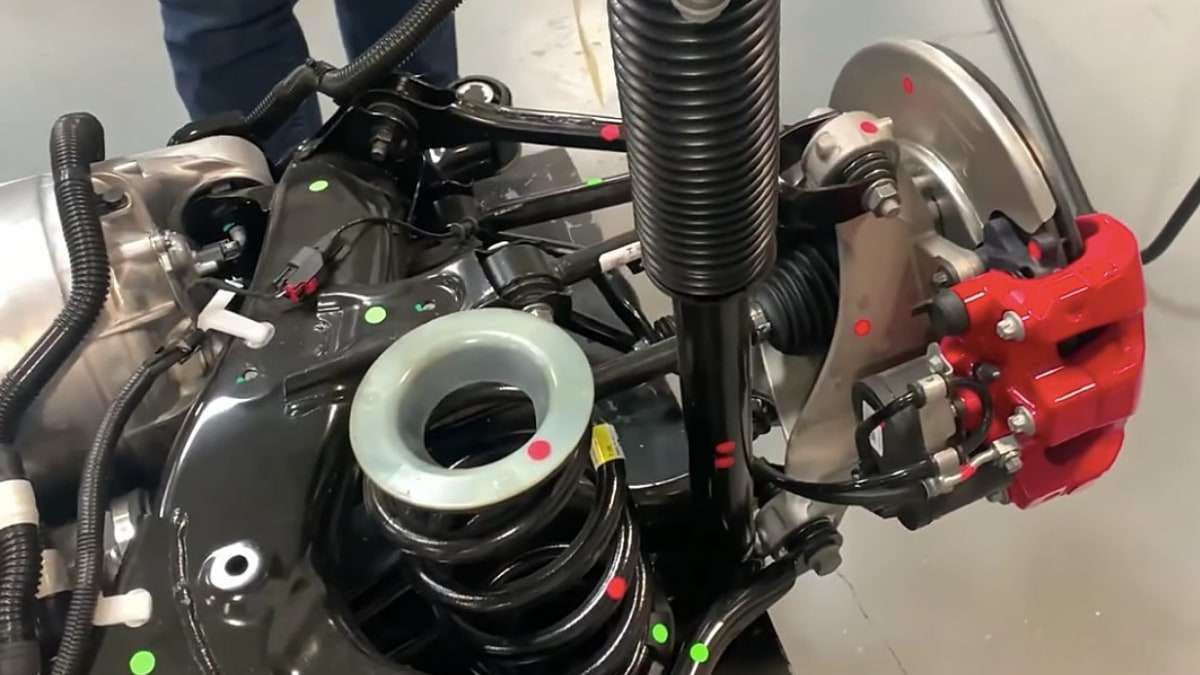Other possible division for springing systems would be based on four basic types: leaf springs, coil springs, torsion bars, and air springs. In modern cars, an air suspension is basically a method of shock absorption by means of rubber bellows (or airbags) filled with compressed air to create a cushioning effect. Air is distributed through hoses to the bellows on each strut to adjust pressure, allowing the vehicle to raise and lower either through manual controls or automatically (as is often the case for self-levelling in trucks that have suddenly received a payload).
In the case of Tesla’s Smart Air Suspension, it features a sensor-calibrated air suspension tech coupled with programming that can adjust the suspension’s height based on GPS location, speed, and driving conditions. It was developed for Model S and Model X, called “Smart Air Suspension” and presented as an option, which eventually became standard in both models. It automatically adjusts the car’s height at different speeds and locations for efficiency and comfort.

Following that logic, Tesla made good use of their “car as an app” strategy to create a suspension system that, as I mentioned above, adapts to the vehicle’s physical location (GPS referred) and its speed via software. Along with the ability to manually adjust the height of the car through the vehicle’s control panel, drivers can expect the car to save the GPS location of the vehicle for each adjustment. Tesla’s Smart Air Suspension software then automatically adjusts the height of the car when it encounters a saved data point, such as a steep driveway, a carwash, or bumpy dirt road.
But going back in time, when launching the Model 3 in 2017 CEO Elon Musk said that the new suspension would launch six months later with the dual motor version of the car. But again, at the time, Tesla ran into a lot of problems ramping up Model 3 production, and a lot of versions of the car were delayed. In 2018, a Tesla Model 3 with dual motor and air suspension was spotted on a racetrack during testing, but nothing came out of it.

While Tesla tested the Smart Air Suspension system out on some development versions of the Model 3, no Model 3 has come off the manufacturing line with Smart Air Suspension installed, and there are no plans to add this feature to the Model 3 at this time. The likely reason for this is that the Smart Air Suspension option would add to the production time and cost of the Model 3, something that Tesla has been trying to avoid while moving the Model 3 as close to mass market manufacturing and pricing as they can. The situation is similar for the Model Y, and though plenty of rumors and hints that there will be some kind of adjustable suspension for both of these vehicles in the future, nothing has solidly surfaced. Tesla has not released any further info that suggests that a future upgrade is in the works.
Later on, when they completed development of their new ‘Raven’ drivetrain, they upgraded the air suspension to what they called Adaptive Suspension, which is now standard on the Model S and Model X as of 2019. Due to cost considerations, the Model 3 and the Model Y did not get Raven’s Adaptive Suspension upgrade. While the Model 3 was the pioneer of a portion of the new Raven technology, allowing Tesla to test out their PMSR motor design before adding it to the Model S and Model X, neither the Model 3 nor the Model Y are set up for the rest of the upgraded drivetrain and tech.

As these two are the economy vehicles in Tesla’s fleet (at least until the rumored Model 2 is released), it looks like coil spring technology is here to stay for now, but that’s not necessarily a bad thing; as the general cost of maintenance and repair on a coil spring suspension is far lower than on an air suspension like the Raven Adaptive Suspension. Cheaper repair costs are especially helpful for buyers considering a used Tesla, and hidden suspension issues could be far less of a financial headache to sort out on a Model 3 or Model Y than they would be on a Model S or Model X with the Raven Adaptive Suspension. Issues with coil spring suspensions tend to be easier to diagnose, too.

Coil springs in trucks allow them to ride smoothly when unloaded and once loaded the spring compresses and becomes stiff. This allows the vehicle to bounce less when loaded. Coil spring suspension is also used in high performance cars (like Tesla Model 3 and Model Y), so that the car can absorb bumps and have low body roll. Coils springs are integral to the car's suspension system, with four coil springs - one for each wheel. As explained before, they are designed to absorb the impact of driving over rough terrain, and also help keep the vehicle at the correct height.
It remains to be seen if Models 3 and Y will ever get the “Smart Air Suspension” that comes standard for Model S and Model X.
Nico Caballero is the VP of Finance of Cogency Power, specializing in solar energy. He also holds a Diploma in Electric Cars from Delft University of Technology in the Netherlands, and enjoys doing research about Tesla and EV batteries. He can be reached at @NicoTorqueNews on Twitter. Nico covers Tesla and electric vehicle latest happenings at Torque News.





